Cooksonia, a very old land plant (II)
(I)
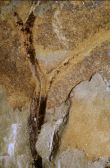  The presence
of xylem vessels with annular or spiral-shaped thickenings at the walls counts
as characteristic for higher plants. Algae and mosses do not have such
tracheids. The presence
of xylem vessels with annular or spiral-shaped thickenings at the walls counts
as characteristic for higher plants. Algae and mosses do not have such
tracheids.
Several stems of Cooksonia show a central black line or thickening,
which is probably the remainder of a xylem strand.
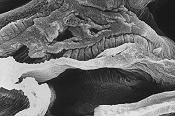 D. Edwards (1992) was the first one to publish photos of xylem vessels of
Cooksonia (Photo with permission of Nature Publishing Group). Edwards
found the tracheids in axes with attached sporangia of the species C.
hemisphaerica en C. pertoni from Lower Devonian river sediments
in
Shropshire.
D. Edwards (1992) was the first one to publish photos of xylem vessels of
Cooksonia (Photo with permission of Nature Publishing Group). Edwards
found the tracheids in axes with attached sporangia of the species C.
hemisphaerica en C. pertoni from Lower Devonian river sediments
in
Shropshire.
Yet there are several snags in the assumption that every plant of
Cooksonia had tracheids. In the first place no tracheids have been
found in Silurian Cooksonia fossils. So it is possible that the tracheids
developed only in the course of time.
Secondly it has been discovered with the use of electron microscopy that
in different species of Lower Devonian plants two kinds of strengthened 'xylem'
strands occurred. One of those appears to be related to the central strands
of mosses ...
Tentatively it is assumed that the oldest Cooksonia's were also
in the possession of tracheids.
Spores
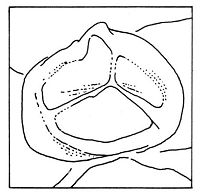 In
most cases no spores are present in the sporangia. Sometimes they have been
preserved, but as a heavily compressed mass in which the individual spores
can hardly be distinguised. Only very seldom have they been preserved in
a rather good, threedimensional form. On the right hand side a drawing after
a SEM-photo of a spore of C. pertoni (diameter 30µms; drawing
J. Hulst). In
most cases no spores are present in the sporangia. Sometimes they have been
preserved, but as a heavily compressed mass in which the individual spores
can hardly be distinguised. Only very seldom have they been preserved in
a rather good, threedimensional form. On the right hand side a drawing after
a SEM-photo of a spore of C. pertoni (diameter 30µms; drawing
J. Hulst).
Research on spores of C. pertoni from different places in Great
Britain has revealed an evolutionary trend. The existence of four different
types of spores in C. pertoni has been proved: two are common and
two rare. There appears to be a tendency from smooth spores in the Silurian
to more ornamented ones in the Early Devonian. Of course the advantage of
ornamented spores for the plant remains uncertain, but it could possibly
be an adaptation to drought.
Comparable smooth spores have been found in the Lower Silurian. Though the
oldest known Cooksonia-fossils are of
Mid-Silurian age, this could point to an even
earlier occurrence of Cooksonia or other plants.
Occurrences
The oldest Cooksonia-fossils have been found in Ireland. They date
from the Late-Wenlock (425 million
years). The preservation is not good enough to identify them at species name,
but they are clearly Cooksonia-like plants with sporangia. Axes without
sporangia are also found, some of them with up to three branchings.
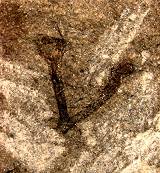  Somewhat
younger Cooksonia-fossils have been found in North-Wales, at a locality
in the Lower Ludlow (420 million years). These
fossils are diminutive. My biggest fossil from this place is a branchlet
with two bifurcations measuring 15 mms. Axes like these are sometimes placed
in the artificial genus Hostinella. Some of the axes show a black
line, probably pointing at the presence of xylem vessels. Somewhat
younger Cooksonia-fossils have been found in North-Wales, at a locality
in the Lower Ludlow (420 million years). These
fossils are diminutive. My biggest fossil from this place is a branchlet
with two bifurcations measuring 15 mms. Axes like these are sometimes placed
in the artificial genus Hostinella. Some of the axes show a black
line, probably pointing at the presence of xylem vessels.
Silurian Cooksonia-fossils have also been found at some other places
in Wales and Shropshire. Edwards even found all four from Great Britain described
species at one locality on the South coast of Wales.
Outside Great Britain Silurian Cooksonia-fossils have been found
in Canada (not identifiable at species name) , Bolivia (resembles C.
caledonica), Czech Republic (C. hemisphaerica), Kazakhstan (not
identifiable), China (the same), Siberia (C. pertoni, C.
hemisphaerica), the state of New York (not yet identified) and perhaps
in Libya.
C. paranenis from Brazil is dated as uppermost Silurian or lowermost
Devonian. This last find demonstrates the occurrence of Cooksonia
at a considerable shale in parts of the large southern continent Gondwana.
Cooksonia also occurs in younger deposits. C. caledonica
has been described on the basis of Lower Devonian fossils from the area
around Forfar (Scotland).
River deposits from the Lower Devonian of England have yielded fragmentary,
but extremely well preserved fossils of all British species of
Cooksonia. Detailed studies could be made of the structure of the
sporangia and the spores of these fossils.
Recently a new species, C. banksii, has been described from this locality,
which resembles very much the Brasilian Cooksonia (Habgood et al,
2002).
Way of growing
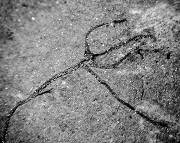  It
is striking that most of the sediments containing Cooksonia are marine ones.
Probably the plant grew at plains along the rivers which became submerged
from time to time. Stems of the plants were then broken off, transported
and buried in the sediments on the bottom of the sea. This could explain
why roots or horizontally growing stems (rhizomes) have
never been found until now. Cooksonia was likely to have rhizomes,
for another early plant, Rhynia, related to Cooksonia, was
attached to the soil in that way. The horizontally growing stems of this
species developed root hairs at places where the stems touched the ground.
Perhaps the strange branching at the right hand side could be a rhizome.
That would be a major find! It
is striking that most of the sediments containing Cooksonia are marine ones.
Probably the plant grew at plains along the rivers which became submerged
from time to time. Stems of the plants were then broken off, transported
and buried in the sediments on the bottom of the sea. This could explain
why roots or horizontally growing stems (rhizomes) have
never been found until now. Cooksonia was likely to have rhizomes,
for another early plant, Rhynia, related to Cooksonia, was
attached to the soil in that way. The horizontally growing stems of this
species developed root hairs at places where the stems touched the ground.
Perhaps the strange branching at the right hand side could be a rhizome.
That would be a major find!
Salt marshes have also been mentioned as possible growing places for
Cooksonia.
It is furthermore likely that the plants were growing in vegetations existing
of only one species. Most of the Early Devonian plants were also living in
such monospecific vegetations.
The Brazilian C. paranensis grew in an area not far from the South
Pole at that time under probably rather extreme circumstances. Though the
flora indicates an ice-free environment, the sunken sporangia appear to be
an adaptation to low temperatures.
Cooksonia probably grew as a small shrub.
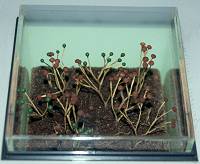 
Top
|